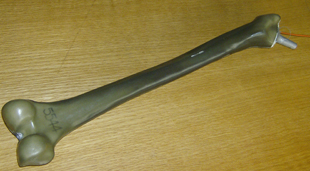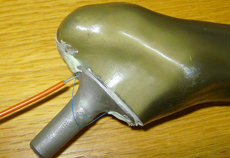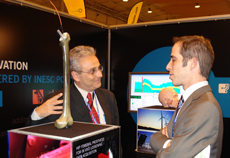H I G H L I G T H
Through fibre sensor implantation and a communication wireless system
INESC Porto revolutionises prevention for hip prosthesis surgery 
INESC Porto is currently developing a pioneer project that consists of applying Bragg sensors to hip prosthesis. These sensors have sensing capabilities that are useful to detect the frequent detachment and the areas where this phenomenon usually occurs throughout time. Using a wireless communication system, this innovative application will enable the definition of clinical correction and prevention methodologies, thus avoiding unnecessary surgery. Currently, they are working on an intelligent prosthesis and the next step is to test this new method on sheep.The importance of a new method
Total hip arthroplasty (THA) is one of the most frequent surgical procedures and one of the most serious complications is the detachment at the interface between the cement and bone-prosthesis. It is frequently mentioned that treatment failure for this reason is higher than 80%. At the same time, the physical exam and the clinical history are proving to be more and more ineffective for the diagnosis of the detachment phenomenon.
In fact, there is no effective technique capable of accurately determining the degree of detachment in the hip prosthesis throughout time or even the areas where it happens. The X-ray technique has been referred as having an accuracy degree between 50 and 100%, which leads us to question its reliability. In Portugal, the cost of a revision is around 5 thousand and 10 thousand Euros, which makes it necessary to find a diagnosis tool that is more reliable in detecting and understanding if the prosthesis is loose or not.
The project’s goal
The community of orthopaedic doctors in Portugal and abroad has proved that there is an urgent need to create a more effective and reliable method. In this context, the project “Hip Femoral Prosthesis for In Vivo Loosening Data Acquisition” started being developed and its main goal is to create a hip prosthesis with sensing capabilities, that is able to detect the degree of detachment and the areas where this phenomenon usually occurs.
According to Orlando Frazão, researcher from the Optoelectronics and Electronic Systems Unit, by implanting the fibre sensor in the prosthesis and using a wireless communication system, the intention is to create a non-invasive monitoring method that allows us to define clinical correction and prevention methodologies. The system will be implemented and studied in a cement prosthesis developed within the doctoral studies of a student from the Faculty of Engineering from the University of Porto (FEUP). The Portuguese patent has already been requested.
Investing in innovation
According to Orlando Frazão, the project can be divided into two parts: the first part corresponds to the monitoring of the hip using optical sensors. For this, Bragg sensors in a special optical fibre will be used, namely Bragg sensors. When this kind of sensor is illuminated, the light is not reflected in the counter-propagation direction. On the contrary, it is sent to the cladding with a specific angle. These sensors have an advantage: when they are glued to a structure, they can determine detachment with angle variation. One of the critical problems with the prosthesis takes place when the prosthesis is glued to the bone and it detaches because it is not properly glued or because of physical effort, which causes the prosthesis to become loose.
The second part of the project consists of supplying the entire electronic system with power. During the team’s last meeting, it was agreed that the system would be supplied with power through special small-sized rechargeable batteries, which are bio-compatible. According to Sérgio Mendonça, responsible for this part of the project, their goal is to “develop a charging system for the battery. The Unit is currently studying a solution that consists of using an ultrasound polymer piezoelectric (PVDF). This way, it is possible to create tension in the PVDF which is optimised by the resonant frequency, converting that variable tension into a stabilised tension impulse that supplies power to the battery”.
Partners and budget
INESC Porto will study the feasibility of using optical sensors in hip prosthesis. On the other hand, the University of Aveiro (the project’s leader) is responsible for the project’s design and characterisation. INEGI – Institute of Mechanical Engineering and Industrial Management will produce the prosthesis, while the University of Trás-os-Montes e Alto Douro is responsible for the electronic development. Finally, the University of Évora is responsible for performing compatibility tests on sheep.
With a 100 thousand Euro investment, the project will last three years. The project’s practical tests will be performed in 2009 by the University of Évora. INESC Porto’s team working on this project is set up by Orlando Frazão, Sérgio Mendonça, Ireneu Dias, Francisco Araújo, Luís Ferreira and José Luís Santos.
The future
The project started being worked on half a year ago, but it has already caught the attention of those who visited the 3rd Innovation Day organised by the Agência de Inovação (AdI), last November, in Lisbon. In fact, even the State Secretary for Science acknowledged its value.
According to Orlando Frazão, “the intention with the future development of the project is to obtain an intelligent prosthesis. This is an effective way to respond internally to the defect (detachment) in the event of prosthesis detachment. One of the solutions is to use actuators in order to compensate for the anomaly caused by the defect”. The researcher concludes by saying that “If it is possible to compensate for the anomaly, the patient won’t need new surgery”. |






